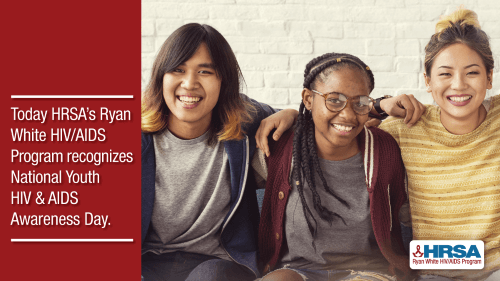HRSA Observes National Youth HIV/AIDS Awareness Day

This Saturday, April 10, is National Youth HIV/AIDS Awareness Day. The Health Resources and Services Administration’s (HRSA) HIV/AIDS Bureau (HAB) observes this day every year to raise awareness of the impact of HIV/AIDS on youth and to highlight the work we are doing to help provide care and treatment for youth and young adults with HIV.
In 2018, youth aged 13 to 24 years old made up 21% of the nearly 38,000 HIV diagnoses in the United States and dependent areas.1 Youth with HIV are also the least likely of any age group to be retained in care and have a suppressed viral load2—meaning they have effectively no risk of transmitting HIV to HIV-negative partners.
HRSA HAB is committed to helping youth and young adults diagnosed with HIV get the care, treatment, and support services they need through the Ryan White HIV/AIDS Program (RWHAP).
The Ryan White HIV/AIDS Program & Youth
For the last 30 years, HRSA has administered the RWHAP, which funds grants to states, cities, counties, and local community-based organizations to provide HIV primary medical care, support services, and medications for low-income people with HIV.
In 2019, about 22,000 youth and young adults, aged 13-24, received services through the RWHAP. The majority of these RWHAP clients are male, low income, and from racial and ethnic minority populations. Of these clients aged 13 to 24, 79.4% were virally suppressed in 2019. While this is an improvement from previous years, it is still below the average viral suppression rate for RWHAP clients overall, which is 88.1%.
HRSA HAB knows that we need to keep youth and young adults engaged and retained in HIV care and treatment to increase their rate of viral suppression. To help do that, we have collaborated with our recipients to develop specific trainings and resources for health care providers who are working with youth and young adults with HIV.
The RWHAP Part F AIDS Education and Training Centers (AETC) Program has several trainings and resourcesExit Disclaimer for health care providers specific to young adults and HIV, and the AETC Program’s National HIV Curriculum includes a course moduleExit Disclaimer on delivering HIV care to adolescents and young adults.
Our Building Futures: Supporting Youth Living with HIV project identified best practices for enhancing services to youth with HIV that contribute to better outcomes in retention and viral suppression. This technical assistance toolkit Exit Disclaimerand webinar seriesExit Disclaimer are useful resources for providers who are delivering HIV care to young people.
The In It Together Health Literacy Project produced a resource guide and trainingsExit Disclaimer designed to help health care professionals incorporate health literacy approaches into their services to improve engagement and retention in HIV care and treatment.
Additionally, one of our previous RWHAP Part F Special Project of National Significance Program initiatives involved implementing and evaluating innovative social media methods to identify, link, and retain HIV positive, underserved, underinsured, and hard-to-reach youth and young adults (aged 13-24) in HIV primary care and supportive services. Summary monographs, replication manuals, and lists of publications are available on TargetHIVExit Disclaimer.
We encourage you to check out these resources to learn more about how to help engage and retain youth and young adults in HIV care and treatment.
For More Information
- Visit the Ryan White HIV/AIDS Program website: hab.hrsa.gov
- Find a RWHAP provider through this interactive map if you or someone you know needs HIV care: https://findhivcare.hrsa.gov/
- Sign up for the HIV/AIDS Bureau listserv
- Follow HRSA on FacebookExit Disclaimer, TwitterExit Disclaimer, and InstagramExit Disclaimer
1 Centers for Disease Control and Prevention. (2020). HIV and Youth. https://www.cdc.gov/hiv/group/age/youth
2 Centers for Disease Control and Prevention. (2020). HIV and Youth. https://www.cdc.gov/hiv/group/age/youth